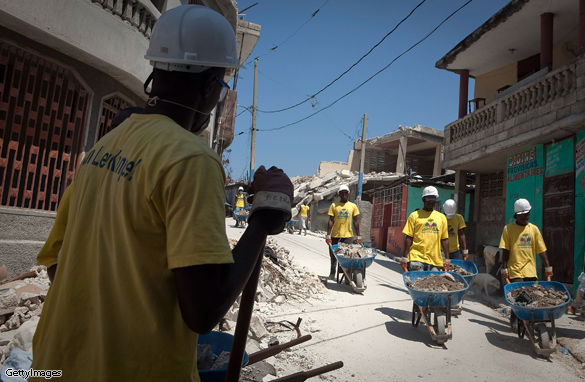Parts of this article were adapted from an article at Popular Mechanics

Rebuilding is an inevitable part of putting our lives back together after a disaster. When an emergency occurs, we need tools to build, repair and maintain our homes to make them livable once more. Those who survived the Haitian earthquake know this all too well. We are all familiar with the devastation that occurred with the Haitian earthquake, the lives lost and the reconstruction still taking place.
According to an article in Popular Mechanics, relief workers who responded to the disaster were asked to bring their own tools in order to rebuild parts of Haiti and they did so using 50 tools. It is ironic that these tools played such a large role in the reconstruction of this broken island. The tools used for reconstruction not only created shelters for families, and areas for sanitation, but they gave the Haitians hope that one day their island would be restored.
In the backbreaking early stages of rubble removal, simple hand tools played a vital role in transporting and removing debris. Acquiring basic hand tools—shovels, axes and hammers—meet immediate demolition needs and then take on a long-term role once construction resumes. The tools used in the first phase of reconstruction were:
1. Round point and square nose shovels, preferably heavy-duty variety with extra long blade socket.
2. Pick axe
3. Pulaski axe
4. Rig builder’s hatchet
5. Axe
6. Bow saw
7. 24-oz. framing hammer
8. Sledge hammer
9. Digging bars, preferably both pointed and chisel tip varieties; crow bars.
10. Leather or synthetic work gloves
11. Protective eye wear
12. Hard hats
13. Dust masks
14. Contractor-grade wheel barrows
15. Bolt cutters
16. Large-diameter heavy-duty weatherproof rope; small-diameter light-duty line
17. Rope hoist/pulley, minimum 250-lb. capacity
18. Folding knife
Shelter construction was the next step in rebuilding Haiti. Simple sheds made of little more than lumber and nails can provide families secure shelter, a measure of sanitation and the stability to endure harsh weather. In the absence of fuel or electricity, fairly sophistication construction can begin with such basic hand tools as saws, braces and squares. The tools and materials used in the second phase of reconstruction were:
Tools
1. 8-point crosscut saw
2. Carpenter’s pencil
3. Carpenter’s square
4. Framing hammers and carpenter’s hammers—smaller sizes for various family members, in addition to the 24-ounce tool above.
5. 25-foot Metric/English tape rule
6. Bit Brace and a set of solid-center auger bits, ¼ inch through 1 inch
7. Utility knife, spare blades
8. High-tension hacksaw and selection of spare blades
Materials
1. 1/2 inch exterior-grade plywood, which has the structural stability to help frame out a building’s wall.
2. 2 x 4 x 8 lumber by the pallet
3. 8-d common nails
4. 12-d and 16-d common nails
5. blue tarps in various sizes (5 x 7, 10 x 10, 12 x 20)
6. 6-mil plastic sheet, roll
7. 5-gallon plastic buckets
8. Self-stick roll roofing
Once the grid comes back up and power and fuel become more widely available, electric or fuel powered tools will take the place of the simple, traditional tools. The power tools tools will resupply Haiti’s population of tradesmen or can equip volunteers aiding in relief efforts. These power tools are:
1. Rotary hammer and bits
2. Hammer drill and bits
3. Reciprocating saw and bi-metal blades
4. Chainsaw (with necessary tools and spare parts: gas cans, funnel, spare spark plug, bar and chain oil, gasoline, chain with carbide-tipped teeth, chainsaw chaps, chainsaw gloves).
5. Gas-engine driven welder/generator and selection of stick electrodes and accessories (welding mask, gloves, welding hammer, C clamps).
6. Right angle grinders and spare grinding wheels.
7. Portable concrete mixer, bags of ready-to-mix concrete.
8. Basic set of concrete and brick/block mason’s tools, rock-working tools: float, trowel, brick/block trowels, plumb bob, brick set, mason’s level, jointer, stone tracer, stone chisel.
9. Simple optical level, such as a builder’s level or transit.
10. Basic electrician’s tool kit (Haiti uses 110-volt power, the same as North America): side-cutting pliers, diagonal pliers, needle-nose pliers, electrician’s multi-tool wire stripper/screw cutter, solenoid voltage tester, fork meter and spare AA batteries.
11. Metric/SAE tap and die set
12. Kerosene and kerosene lanterns, waterproof matches
13. Charcoal and charcoal grills
14. Chlorine bleach for water disinfection, Lifestraws or similar filtration tools, and refillable water bottles
15. Anti-bacterial soap, shop towels, and toilet paper.
Quite simply, having these tools and equipment on hand will help you operate in a non-technological environment. Investing in quality tools could assist in rebuilding your home and lives more quickly and efficiently.
A special thanks to all the relief workers who participated in rebuilding this island and giving hope back to the Haitians. Your volunteerism is a true act of kindness and a great example of the human spirit.
This article was originally published at Ready Nutrition™ on September 29th, 2011







Great couple of articles on tools. I noted a couple I don’t have. Luckily Christmas is right around the corner and I think I can sneak in the ones that we don’t have.